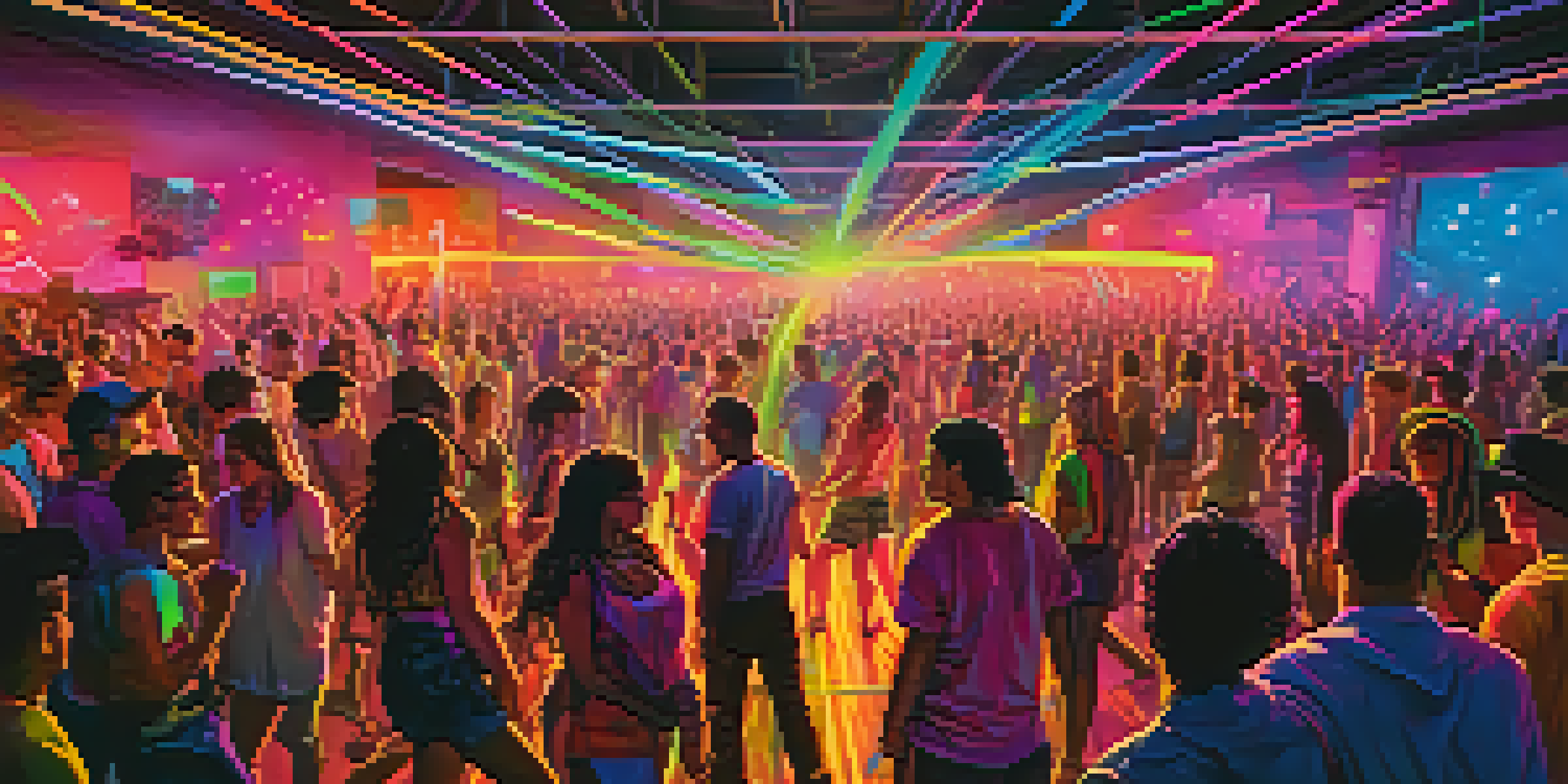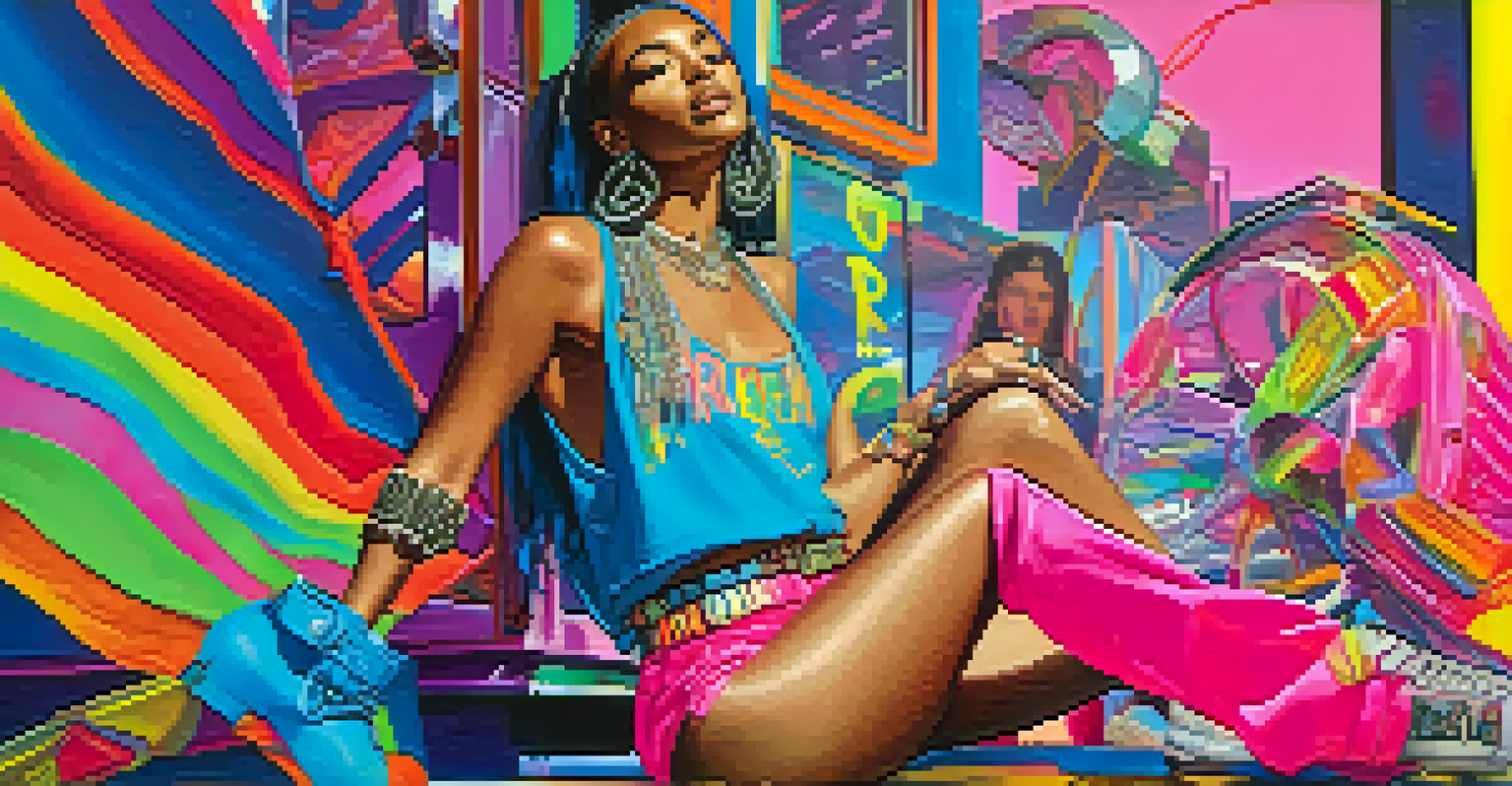The 1990s Rave Scene: Evolution of LA Nightlife Culture

The Birth of the Rave Scene in Los Angeles
In the early 1990s, Los Angeles was a melting pot of musical styles and cultural expressions, laying the groundwork for the rave scene. Underground parties began to emerge, often held in warehouses or abandoned spaces, where electronic music took center stage. These events attracted a diverse crowd, from club-goers to artists, all seeking an escape from the mainstream nightlife.
Rave culture is a celebration of life, where music and community intertwine to create a space of freedom and expression.
The allure of the rave was its sense of community and freedom, where attendees could express themselves without judgment. With pulsating beats and vibrant visuals, these gatherings felt like a celebration of life itself. It wasn’t just about the music; it was about creating a safe space for self-expression and connection.
As the scene grew, so did its notoriety, drawing attention from both local law enforcement and the media. Raves began to be seen not just as parties, but as cultural phenomena that challenged societal norms. This tension would shape the evolution of rave culture in LA and beyond.
The Role of Electronic Music in Rave Culture
At the heart of the rave scene was electronic music, a genre that found its roots in disco and punk but evolved into something entirely unique. From house to techno, these genres provided the soundtrack to nights filled with dancing and euphoria. DJs became the new rock stars, mixing tracks that created an electric atmosphere, often leading to spontaneous moments of joy.

The rise of iconic DJs like Paul Oakenfold and Sasha brought international attention to the LA rave scene. Their remixes and sets were not just performances; they were immersive experiences that resonated with the crowd. This shift marked a departure from traditional music concerts, as the focus shifted from the artist to the audience’s collective experience.
Rave Scene: A Cultural Revolution
The 1990s rave scene in Los Angeles fostered a sense of community and self-expression, challenging societal norms and creating safe spaces for diverse connections.
As more people embraced electronic music, the genre began to influence other aspects of popular culture, from fashion to art. The vibrant energy of rave music spilled into mainstream consciousness, leading to collaborations across various artistic platforms and solidifying its place in LA’s rich nightlife history.
Fashion and Identity in the Rave Scene
Rave culture was as much about the music as it was about fashion and identity. Attendees often donned colorful, eclectic outfits that reflected their personalities, from neon colors to glow-in-the-dark accessories. This visual representation of individuality became a hallmark of the rave scene, showcasing the freedom to express oneself creatively.
Music is the soundtrack of our lives, and in the rave scene, it becomes a shared experience that transcends boundaries.
The fashion associated with raves often drew inspiration from various subcultures, including punk, hip-hop, and even futuristic styles. This blending of influences created a unique aesthetic that was both playful and rebellious. Participants embraced this opportunity to break away from conventional fashion norms, celebrating diversity in all its forms.
Over time, the rave fashion scene influenced mainstream trends, with elements like oversized pants, bright colors, and unique accessories making their way into everyday wear. The impact of rave culture on fashion illustrated a deeper connection between self-expression and community, highlighting how style can unify people from different walks of life.
Legal Challenges and the Rave Scene
As the rave scene gained popularity, it also faced significant legal challenges. Authorities began cracking down on these underground parties, often citing noise complaints and concerns about drug use. The increasing scrutiny led to a perception that raves were dangerous, forcing organizers to adapt their approaches to keep the parties alive.
In response to these challenges, many rave promoters began to explore more legitimate venues, like clubs and event spaces. While this shift helped legitimize the scene, it also changed the dynamic of the parties, as they became more commercialized. This evolution sparked debates within the community about authenticity and the essence of the rave experience.
Electronic Music as a Unifier
Electronic music became the heartbeat of the rave culture, transforming DJs into rock stars and shifting focus from individual artists to the collective experience of the audience.
Despite the legal hurdles, the spirit of the rave continued to thrive. Many organizers found creative ways to navigate regulations while still providing a platform for self-expression and connection. This resilience demonstrated the power of community in the face of adversity and laid the groundwork for the future of LA nightlife.
The Influence of the Internet on the Rave Scene
The advent of the internet in the 1990s played a crucial role in the evolution of the rave scene. Online forums and websites became essential platforms for sharing information about upcoming events, allowing ravers to connect and organize more efficiently. This digital revolution opened doors for both organizers and attendees, making it easier to find like-minded individuals passionate about the culture.
As rave culture spread beyond Los Angeles, the internet helped foster a global community united by a shared love for electronic music. Social media platforms allowed for real-time updates and interactions, creating a sense of immediacy that wasn’t previously possible. This interconnectedness helped solidify the rave scene as a worldwide phenomenon.
However, the rise of the internet also brought challenges, such as commercialization and the dilution of the authentic rave experience. As events became easier to find, some lost the underground vibe that initially attracted many to the scene. Nonetheless, the internet has played an undeniable role in shaping the landscape of rave culture and LA nightlife.
Cultural Impact of Raves Beyond Music
The cultural impact of the 1990s rave scene extended far beyond just music and dance. Raves became spaces for social change, where issues like inclusivity, love, and acceptance were celebrated. The ethos of peace, love, unity, and respect (often abbreviated as PLUR) became a guiding principle for many within the community, fostering a sense of belonging and camaraderie.
This cultural movement also influenced art, with vibrant visual displays, graffiti, and installations becoming integral to the rave experience. Artists began to explore themes of freedom and connection in their work, often inspired by the energy and spirit of the rave scene. This synergy between music and art led to innovative collaborations that enriched both cultures.
Fashion and Identity at Raves
Rave fashion celebrated individuality and creativity, blending various subcultures to create a unique aesthetic that influenced mainstream trends and highlighted the power of personal expression.
Moreover, the rave scene actively engaged with pressing social issues, including drug awareness and mental health. Many events incorporated educational resources and harm reduction strategies, aiming to create safer spaces for attendees. This commitment to social responsibility showcased how the rave culture could evolve while remaining true to its core values.
The Legacy of the 1990s Rave Scene in LA
Today, the legacy of the 1990s rave scene continues to influence LA nightlife and beyond. The principles of community, self-expression, and inclusivity remain at the forefront of many contemporary events. Major music festivals and club nights still draw inspiration from the vibrant energy of the rave culture, keeping its spirit alive for new generations.
As electronic music continues to dominate the global music scene, the impact of the 1990s rave culture is undeniable. Artists and DJs frequently pay homage to the roots of rave, incorporating nostalgic elements into their performances. This connection to the past helps bridge the gap between generations, ensuring that the essence of the rave scene is never forgotten.

Ultimately, the 1990s rave scene in LA represents a unique chapter in the city’s cultural history. It paved the way for a rich tapestry of nightlife experiences that celebrate creativity, connection, and the power of music. The enduring legacy of this era serves as a reminder of the transformative power of community and self-expression.